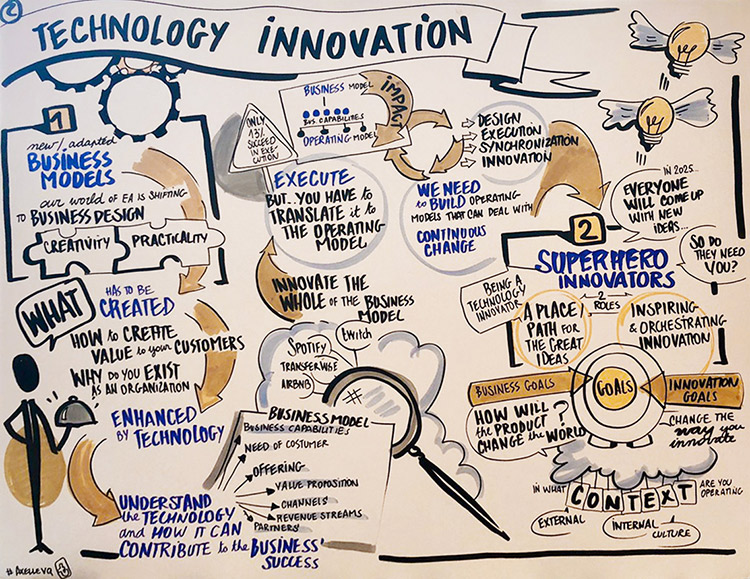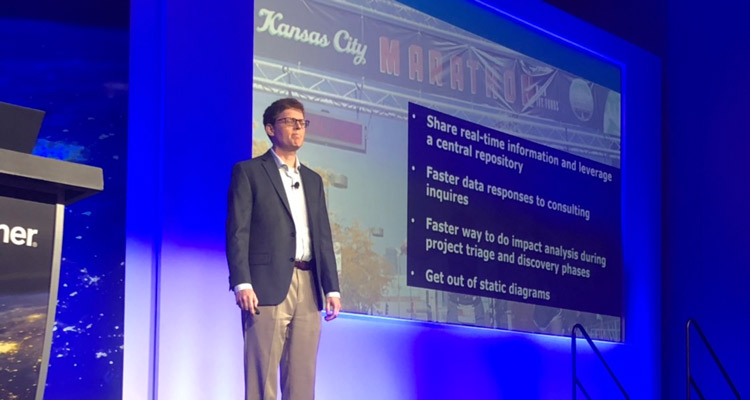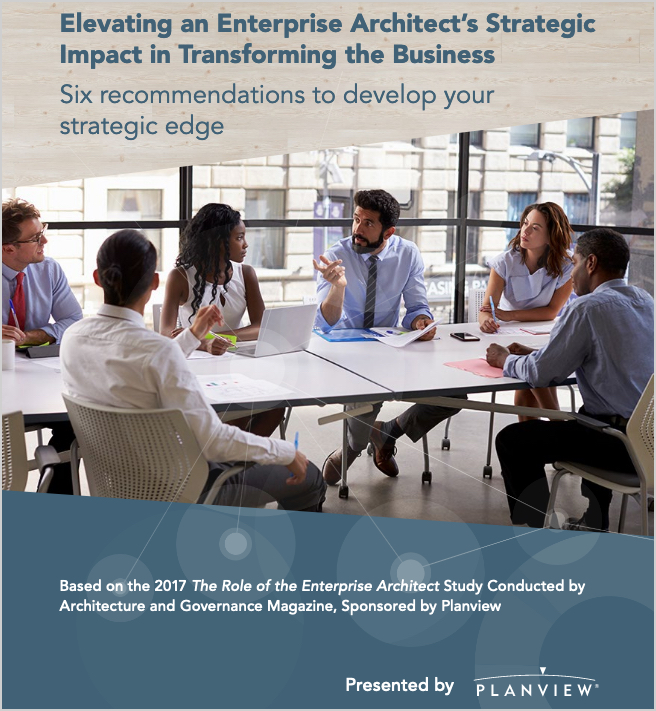
The 2019 Gartner Enterprise Architecture and Technology Innovation Summit was held in Orlando, FL on May 14th and 15th. Summit guest keynote speakers, experienced practitioners, and Gartner analysts provided some valuable perspectives and takeaways for attendees to consider. There were so many great presenters including Saul Brand and James McGovern, both Senior Director Analysts at Gartner and Matt Higgins with Blue Cross Blue Shield – Kansas City (BCBS-KS) discussed how their enterprise architects contributed to some amazing accomplishments.
The Expanded Role of Enterprise Architects
The summit included a discussion of new trends of the expanded role of enterprise architects and how they must shift to:
- Architects as advisors: Enterprise architects need to understand the opportunity to become a consultant or advisor with a focus on business outcomes. Enterprise architects are at an inflection point; there is an opportunity because CEOs are looking at ways technology and digital platforms can generate revenue and create a competitive advantage. There is an opportunity to reshape the enterprise architecture program and align efforts toward business strategy. To be strategic in the decision-making process, enterprise architecture initiatives must be based on active engagement with executives and business leaders on real business challenges.
“Help senior leaders and product managers plan, describe, innovate, orchestrate, navigate, and operationalize the digital platform.”
- Architects as technologists: Many enterprise architects understand how important it is to be informed about emerging technology, however, one emphasis now should also be placed on how to apply emerging technologies to IT efforts and the business strategy. An example was presented during the case study presentation, “Leveraging EA to Drive Growth and Strategic M&As” where CommScope uses their solution, imVision to augment reality by overlaying visual cues to their server and switches infrastructure uncovering hidden physical cables providing technicians better network visibility which helps increase process efficiencies and productivity. CommScope’s example showcases how a company can understand, find, and seize strategic moments to move forward to be at the forefront of leading-edge innovation.
- Architects as innovators: When asked, “What is your role with respect to business strategy planning?”, Gartner’s research states that 65 percent of modern enterprise architect leaders support technology innovation and 16 percent are taking a leadership role. Some key factors to consider when building innovation into your business processes include:
- Innovation needs to happen across silos
- Innovation requires a coordinated focus and a willingness to take risks
- Organizations need to incorporate a continuous innovation framework with a path for big ideas to be generated through such means as innovation challenges or hackathons
- Learn and understand the available viable options, and how to select and apply new technology as opportunities arise (mentioned from the opening Gartner Keynote)
- Architects as problem solvers: Marty Resnick recommends enterprise architects take an innovative approach to problem solving by incorporating design thinking to uncover untapped opportunities. Design thinking starts with empathy to define and frame customer challenges or problems. Ideas can then be generated, iterated on, and measured from this framing. James McGovern also suggested adopting a visual, structured approach to problem solving and uncover the root cause with the business stakeholders. A suggestion was made to use the 5 whys approach to brake down the problem. Once you know what the problem is, get up from your desk, get out of your building, and visit with others to see how solutions will work in the real world.
Knapp responded to this question by demonstrating the design process which starts off by asking a group of people in a variety of roles to wipe their calendars clean for one week. Having a clean calendar provides for the dedicated time and focus cultivating productivity to prototype and test a product idea or design–from start to finish in one week. The process involves sketching, prototyping, and faking it with quick and dirty test data. Participants had to overcome their tendencies to (over) plan with endless discussions about what should or not happen. Although this was a challenge for many, at the end of the week and after a handful of user interviews, the team had a solid understanding of what worked and what didn’t. Even if their tests failed, participants felt safe knowing that this was a one-week test. A valuable lesson for those involved was they could learn from their failings and repeat the process to improve for the next time.
Top 3 Trends Revealed at the Summit
- The role of the EA is evolving. Enterprise architects are now seen as a collaborator and leader in evaluating emerging technology. The question, “What is the role of the Enterprise Architect in your organization’s evaluation of emerging technologies?” was included in a survey noted from Marty Resnick’s, “The Innovative Enterprise Architect” presentation. The survey results showed that:
- 52% of enterprise architects collaborate with others to make decisions
- 21% of enterprise architects lead strategy and decision-making responsibilities
This evolving role requires new skill sets such as the ability to connect technology to business models and outcomes.
- Digital business models are a priority for CEOs. Fifty-nine percent of CEOs surveyed, seeks to create innovative new business models which aligns with the statement made at one of the presentations:
“You can’t do EA without technology innovation and you can’t do technology innovation without EA.” – Saul Brand, Senior Director Analyst, Gartner
Enterprise architects can have a powerful role in supporting and innovating new business models with technology innovation to create new experiences for the customer. They can evaluate market conditions and match use cases to their business capabilities. Uber, Spotify, and Tesla are great examples of how companies are incorporating innovative technologies which brings new capabilities to the table and new products and services to their customers. Enterprise architects are asking, “How can new technology help logistics and supply chain management deliver products faster and more precisely to customers?”
- Consumers and employees will more actively engage in immersive experiences, such as virtual reality. Marty Resnick offered the following statistics from his “Architecting for Immersive Experiences” presentation:
- By 2020, 30% of large enterprises will adopt augmented reality applications on mobile devices as part of their digital transformation strategy. An example is using technology that overlays digital information onto the physical world or using augmented reality via head-mounted displays to provide report field support.
- Forty-four percent, however, lack a clear business strategy and 30% lack a clear process which agrees with this assertion made at one of the summit’s presentations:
“Strategy, not technology, is the future state of EA.” – James McGovern, Senior Director Analyst, Gartner
Shout out to Blue Cross Blue Shield – Kansas City for Sharing their Amazing Story

Matt Higgins from Blue Cross Blue Shield in Kansas City (BCBS-KC) gave an informative presentation titled, “Leading at the Intersection of Technology Innovation and Business Transformation” and how they overcame issues with decision making based on fragmented or partial data and not properly understanding the significance of work as it related to business goals and objectives by advancing:
- Decision Support: Enterprise architects had a role in helping the organization with key business decisions. Their input helped their CTO with the development of their cloud strategy. Input was also helpful when overcoming organizational efficiencies and new plans were created to with departmental reorganizations and to find the best ways to support product lines. Enterprise architects were instrumental in how IT improved their security capability road-mapping and finding new growth opportunities.
- Self-Service: Teaming with their enterprise architects, their internal organization can now better answer questions that would have been difficult to answer in the past. For example:
- What is the progress on migrating applications to the cloud? What applications are likely candidates to move next?
- What capabilities require near term investments?
- What applications work with public, private, and restricted information?
- Making the Product Shift: Capability and technology management supports BCBS-KC’s ability to pivot to owning capabilities (or what Planview calls, the product shift). Leadership can see what capabilities they need to foster, where the focus should be, and how capabilities tie to goals and strategies to understand the significance of the work.
- Single Source of Truth/Breaking Down Silos: In the past, BCBS-KC had different central repositories (SharePoint and metadata repository) making it difficult to connect essential resources, or even provide access. This was the case if a team member left the company and took that knowledge with them. Capability and technology management provides a straightforward and easy way to navigate information and resources giving team members a head start on new initiatives.
- Faster Time to Delivery: BCBS-KC now has a shared understanding of their priorities and one place to go get that understanding. In the past, during the discovery phase of an epic effort, the organization would have to invite a large number of team members to understand the required resources (people, skills, technology, and capabilities) involved. It could be time consuming and frustrating to get that information. Now, things happen faster with capability and technology management because the required information is immediately available. Another benefit is there is a faster, more efficient way to triage projects or epics without having to rely on static diagrams.
This is an exciting time to be an enterprise architect. Just as technology is quickly evolving, so is the role of the enterprise architect. Learn more about how your enterprise architects can transform your business strategy with technology innovation by reviewing Elevating an Enterprise Architect’s Strategic Impact in Transforming the Business, an executive summary based on the 2017 The Role of the Enterprise Architect Study conducted by Architecture and Governance Magazine, sponsored by Planview.


![MassMutual Captures the Advances Enterprise Architecture Capabilities [Webinar]](https://blog.planview.com/wp-content/uploads/2018/08/MassMutual.gif)



